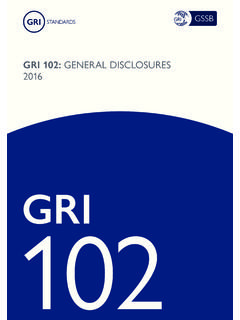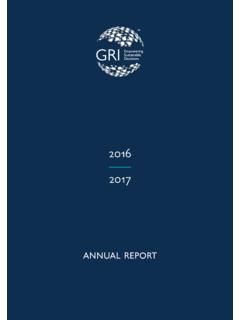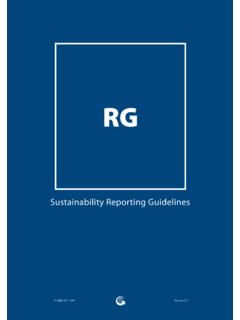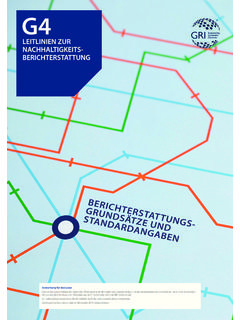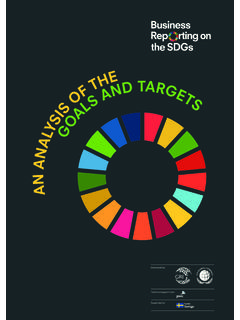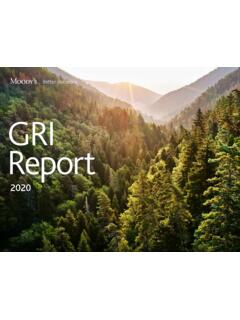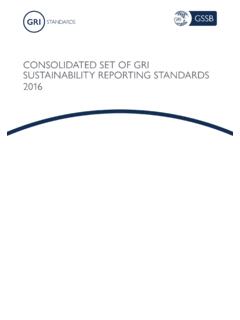Transcription of GRI 413: LOCAL COMMUNITIES 2016 - Global Reporting …
1 gri 413 : LOCAL COMMUNITIES 2016 GRI 4132 gri 413 : LOCAL COMMUNITIES 2016 ContentsIntroduction 3 gri 413 : LOCAL COMMUNITIES 51. Management approach disclosures 52. Topic-specific disclosures 7 Disclosure 413-1 Operations with LOCAL community engagement, impact assessments, and development programs 7 Disclosure 413-2 Operations with significant actual and potential negative impacts on LOCAL COMMUNITIES 9 Glossary 11 References 13 ResponsibilityThis Standard is issued by the Global Sustainability Standards Board (GSSB). Any feedback on the GRI Standards can be submitted to for the consideration of the GSSB. ScopeGRI 413: LOCAL COMMUNITIES sets out Reporting requirements on the topic of LOCAL COMMUNITIES .
2 This Standard can be used by an organization of any size, type, sector or geographic location that wants to report on its impacts related to this referencesThis Standard is to be used together with the most recent versions of the following 101: FoundationGRI 103: Management Approach GRI Standards GlossaryIn the text of this Standard, terms defined in the Glossary are dateThis Standard is effective for reports or other materials published on or after 1 July 2018. Earlier adoption is this Standard Note: This document includes hyperlinks to other Standards. In most browsers, using ctrl + click will open external links in a new browser window. After clicking on a link, use alt + left arrow to return to the previous 413: LOCAL COMMUNITIES 2016A.
3 Overview This Standard is part of the set of GRI Sustainability Reporting Standards (GRI Standards). These Standards are designed to be used by organizations to report about their impacts on the economy, the environment, and GRI Standards are structured as a set of interrelated, modular standards. The full set can be downloaded at There are three universal Standards that apply to every organization preparing a sustainability report:GRI 101: FoundationGRI 102: General DisclosuresGRI 103: Management Approach An organization then selects from the set of topic-specific GRI Standards for Reporting on its material topics. These Standards are organized into three series: 200 (Economic topics), 300 (Environmental topics) and 400 (Social topics).
4 Each topic Standard includes disclosures specific to that topic, and is designed to be used together with GRI 103: Management Approach, which is used to report the management approach for the Using the GRI Standards and making claims There are two basic approaches for using the GRI Standards. For each way of using the Standards there is a corresponding claim, or statement of use, which an organization is required to include in any published materials. 1. The GRI Standards can be used as a set to prepare a sustainability report that is in accordance with the Standards. There are two options for preparing a report in accordance (Core or Comprehensive), depending on the extent of disclosures included in the report.
5 An organization preparing a report in accordance with the GRI Standards uses this Standard, gri 413 : LOCAL COMMUNITIES , if this is one of its material topics. 2. Selected GRI Standards, or parts of their content, can also be used to report specific information, without preparing a report in accordance with the Standards. Any published materials that use the GRI Standards in this way are to include a GRI-referenced 413: LOCAL COMMUNITIES is a topic-specific GRI Standard in the 400 series (Social topics).GRI 101: Foundation is the starting point for using the GRI Standards. It has essential information on how to use and reference the Standards.
6 GRI 103 GRI 102 Topic-specificStandardsUniversal StandardsStarting point for using the GRI StandardsGRI 101 FoundationGeneral DisclosuresManagement ApproachTo report contextual information about an organizationTo report the management approach for each material topicSelect from these to report specific disclosures for each material topicGRI 300 EnvironmentalGRI 400 SocialGRI 200 EconomicFigure 1 Overview of the set of GRI StandardsSee Section 3 of GRI 101: Foundation for more information on how to use the GRI Standards, and the specific claims that organizations are required to include in any published materials. 4 gri 413 : LOCAL COMMUNITIES 2016C. Requirements, recommendations and guidance The GRI Standards include: Requirements.
7 These are mandatory instructions. In the text, requirements are presented in bold font and indicated with the word shall . Requirements are to be read in the context of recommendations and guidance; however, an organization is not required to comply with recommendations or guidance in order to claim that a report has been prepared in accordance with the These are cases where a particular course of action is encouraged, but not required. In the text, the word should indicates a recommendation. Guidance. These sections include background information, explanations and examples to help organizations better understand the organization is required to comply with all applicable requirements in order to claim that its report has been prepared in accordance with the GRI Standards.
8 See GRI 101: Foundation for more Background contextIn the context of the GRI Standards, the social dimension of sustainability concerns an organization s impacts on the social systems within which it operates. GR I 413 addresses the topic of LOCAL COMMUNITIES . In the GRI Standards, LOCAL COMMUNITIES are defined as persons or groups of persons living and/or working in any areas that are economically, socially or environmentally impacted (positively or negatively) by an organization s operations. The LOCAL community can range from persons living adjacent to an organization's operations, to those living at a distance who are still likely to be impacted by these organization s activities and infrastructure can have significant economic, social, cultural, and/or environmental impacts on LOCAL COMMUNITIES .
9 Where possible, organizations are expected to anticipate and avoid negative impacts on LOCAL COMMUNITIES . Establishing a timely and effective stakeholder identification and engagement process is important to help organizations understand the vulnerability of LOCAL COMMUNITIES and how these might be affected by the organization s to the heterogeneous nature of LOCAL COMMUNITIES , an organization is expected to consider the differentiated nature of COMMUNITIES and the distinct and specific vulnerabilities these groups can suffer as a result of the organization s activities. These concepts are covered in key instruments of the Organisation for Economic Co-operation and Development and the United Nations: see disclosures in this Standard can provide information about an organization s impacts related to LOCAL COMMUNITIES , and how it manages these impacts.
10 5 gri 413 : LOCAL COMMUNITIES 2016 This Standard includes disclosures on the management approach and topic-specific disclosures. These are set out in the Standard as follows: Management approach disclosures (this section references GRI 103) Disclosure 413-1 Operations with LOCAL community engagement, impact assessments, and development programs Disclosure 413-2 Operations with significant actual and potential negative impacts on LOCAL communitiesReporting The Reporting organization shall report its management approach for LOCAL COMMUNITIES using GRI 103: Management 413: LOCAL Communities1. Management approach disclosuresManagement approach disclosures are a narrative explanation of how an organization manages a material topic, the associated impacts, and stakeholders reasonable expectations and interests.
